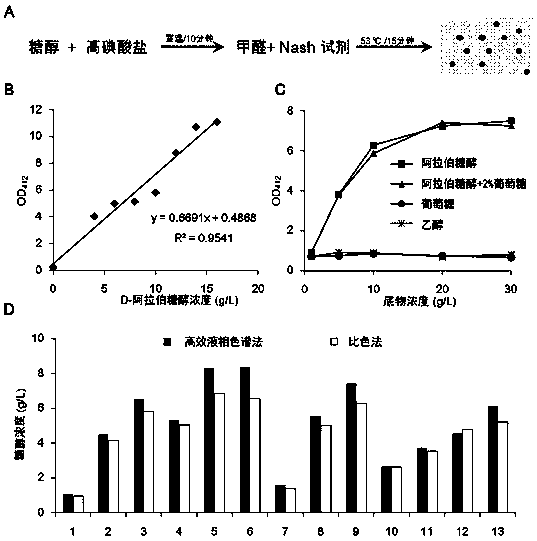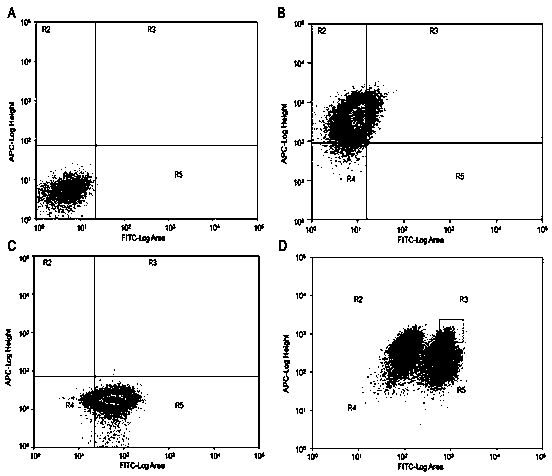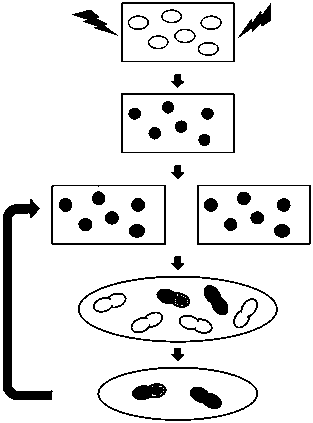Construction and application of genome rearrangement technology of a sugar alcohol-producing yeast strain
A technology of sugar alcohol and recombinant strains, applied in the direction of microorganism-based methods, fungi, and treatment of microorganisms with electricity/wave energy, to achieve low cost, high safety factor, and simple operation
- Summary
- Abstract
- Description
- Claims
- Application Information
AI Technical Summary
Problems solved by technology
Method used
Image
Examples
Embodiment 1
[0016] Example 1: Construction and optimization of high-efficiency sugar alcohol colorimetric screening method: Prepare 4, 6, 8, 10, 12, 14, 16 (g / L) D-arabitol standard solutions respectively, and add 20 μl of the standard solutions to Deep well plate, then add 500 μl potassium periodate solution. After mixing, it was left at room temperature for 10 minutes, and then 400 μl of 1% L-rhamnose solution was added to neutralize excess periodate ions. After further mixing, 600 μl of Nash reagent was added and reacted at 63° C. for 20 minutes. After cooling, transfer 200 μl of the reaction solution to a shallow well plate, detect its absorbance at 412 nm, and make a standard curve. According to the above method, take 20 μl of the sample to be tested for detection, and the accumulation of sugar alcohol can be judged according to OD412.
[0017] Polysaccharide alcohols are oxidized by periodate under acidic conditions (pH1.0) to generate formaldehyde, and the residual periodate is n...
Embodiment 2
[0021] Example 2 Construction of a yeast protoplast fusion screening method based on dual fluorescent dye markers: In yeast protoplast fusion, when two yeast strains containing complementary genetic markers are fused, their fusions can grow on selective media. However, many industrial yeast strains, due to the lack of selectable genetic markers, cannot achieve complementary selection of genetic markers [12]. In order to solve this problem, fluorescence activated cell sorting (fluorescence activated cell sorting, FACS) as an effective method is applied to fusion cell screening. In this method, parental strains are labeled with different fluorescent dyes, and fusions containing overlapping fluorescent stains are screened by flow cytometry. This technique is currently used in some applications, but has not yet formed a systematic approach [13-15].
[0022]In the present invention, first prepare 1.0ml of different parental yeast protoplasts, stain with 0.25μM NuclearGreen and 0.1...
Embodiment 3
[0024] Example 3 Application of a new genome rearrangement technology in the improvement of the sugar alcohol-producing strain Pichia anomaly: In order to further effectively improve the yeast sugar alcohol production performance, the strains (U-7, 9 and A-1, 4) is the starting bacterium. Using the new genome rearrangement technology constructed, different high-yield sugar alcohol strains are combined and rearranged to screen strains with excellent performance. The specific process is as follows image 3 . First, the strains were activated and cultured in YPD liquid medium for 12 hours to the logarithmic growth phase, and then the cell wall was removed. After treatment with 2.5% helicase solution at 30°C for 3 hours, the strains were observed by microscope inspection and plate coating. At this time, they had better Protoplast formation rate and regeneration rate. Next, the prepared protoplast cells were labeled with different fluorescent dyes (Nuclear Green and Nuclear Red), ...
PUM
 Login to View More
Login to View More Abstract
Description
Claims
Application Information
 Login to View More
Login to View More - R&D
- Intellectual Property
- Life Sciences
- Materials
- Tech Scout
- Unparalleled Data Quality
- Higher Quality Content
- 60% Fewer Hallucinations
Browse by: Latest US Patents, China's latest patents, Technical Efficacy Thesaurus, Application Domain, Technology Topic, Popular Technical Reports.
© 2025 PatSnap. All rights reserved.Legal|Privacy policy|Modern Slavery Act Transparency Statement|Sitemap|About US| Contact US: help@patsnap.com



